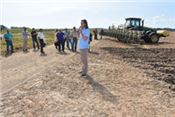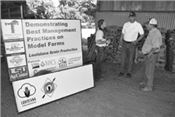|
Model Farm Field Tour Held In Tensas Parish
NEWELLTON, LA.
Good stewardship of the land was the focus of a fall farm tour held at Somerset Plantation in Tensas Parish on Sept 24.
The farm, which is owned and operated by Jay Hardwick and his family, is one of two model farms that are part of a $1.4 million grant to the LSU AgCenter from the Patrick F. Taylor Foundation to study ways to decrease the amount of chemicals such as fertilizer used in agriculture. The other location is the Keith Dugas farm in Assumption Parish.
The Hardwicks grow corn, cotton, grain sorghum, soybeans and wheat, while Dugas farms sugarcane.
There was a tour of the Dugas farm earlier this month.
James Caillier, executive director of the Taylor Foundation, said the organization is happy to be a part of the conservation efforts of agriculture in Louisiana.
“We get the blame in Louisiana for a lot of the nutrients and chemicals that are causing the dead zones in the Gulf,” he said. “But in reality, the problem starts way up north and settles at the mouth of the Mississippi and causes the problems.”
The tour gave AgCenter scientists a chance to explain the work they will be doing on the farm in the four years of the project.
AgCenter soil scientists Lisa Fultz and Brenda Tubaña are working with both farmers to help them implement the projects.
Fultz said the plan is to prepare the fields this year and not do any more plowing for the next four years.
“That’s our plan. We’ve done it at the station, but that’s a lot of small plot research,” she said. “We want to see if it can be done on a larger scale here at the farm.”
Some of the practices being implemented on the farm are no-till and minimum till farming, integrated pest management and variable-rate technology for soil fertility.
Fultz said once the crops are harvested, cover crops will be planted to try to maintain the integrity of the rows without having to put any equipment in the field.
Besides the Hardwick farm, the group visited the LSU AgCenter Northeast Research Station in St. Joseph.
Research there is looking at cover crops in corn, soybean and cotton, and those findings will become a part of the project at Somerset.
The goal of the project is to study practices farmers can implement to decrease the amount of nitrogen and phosphorous fertilizers, pesticides and other inputs needed to grow a successful crop, Fultz said.
With that done, there should be a significant reduction in nutrient runoff that contributes to hypoxia, or inadequate oxygen, in the Gulf of Mexico.
“We’ll be planting a number of legumes as cover crops because they will fix nitrogen from the atmosphere and help to reduce the amount of fertilizer needed on the fields,” she said.
Partner agencies will help disseminate information on the findings from the project. Those organizations include the U.S. Department of Agriculture Natural Resources Conservation Service, Louisiana Department of Environmental Quality, Louisiana Association of Conservation Districts, American Sugar Cane League, and Louisiana Soybean and Grain Research and Promotion Board.
The program ended with the presentation of the first Hardwick Family Internship Awards, which include a plaque and a $500 check.
Melissa Cater, director of the AgCenter Northeast Region, said these awards will go to students who worked on the station this summer as a way to help them with their school expenses. ∆

Marshall Hardwick, one of the owners of Somerset Plantation in Tensas Parish, discusses best management practices during a tour on Sept. 24.The farm is one of two LSU AgCenter model farms in the state. The project, which is financed by a $1.4 million grant from the Patrick F. Taylor Foundation, is designed to study ways to decrease the amount chemicals such as fertilizer used on the farm.
Photo by Johnny Morgan/LSU AgCenter

Members of the LSU AgCenter model farm team discuss the four-year project during a tour of the Somerset Plantation in Tensas Parish on Sept. 24. The project, which is financed by a $1.4 million grant from the Patrick F. Taylor Foundation, is designed to study ways to decrease the amount of chemicals, such as fertilizer, used on the farm. Pictured left to right are Renada Davis, student worker; James Caillier, executive director of theTaylor Foundation; and James Hendrix, AgCenter agent.
|
|